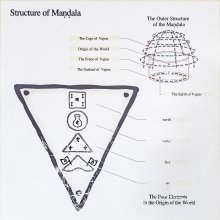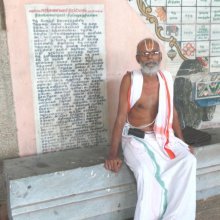Pain, Paiṇ: 10 definitions
Introduction:
Pain means something in Hinduism, Sanskrit, the history of ancient India. If you want to know the exact meaning, history, etymology or English translation of this term then check out the descriptions on this page. Add your comment or reference to a book if you want to contribute to this summary article.
Images (photo gallery)
In Hinduism
Shilpashastra (iconography)
Source: Shodhganga: Elements of Art and Architecture in the Trtiyakhanda of the Visnudharmottarapurana (shilpa)Pain is associated with the Eye in the shape of an arrow, which follows specific guidelines of ancient Indian Painting (citra), according to the Viṣṇudharmottarapurāṇa, an ancient Sanskrit text which (being encyclopedic in nature) deals with a variety of cultural topics such as arts, architecture, music, grammar and astronomy.—In the Viṣṇudharmottarapurāṇa also, different kinds of eyes and their particular shapes are elaborately discussed in the context of Painting. The fifth variety of eye should be in the shape of a śara i.e., an arrow and the measurement should be ten yavas. This kind of eyes should be attached with the portrait of a person who is in anger or pain.

Shilpashastra (शिल्पशास्त्र, śilpaśāstra) represents the ancient Indian science (shastra) of creative arts (shilpa) such as sculpture, iconography and painting. Closely related to Vastushastra (architecture), they often share the same literature.
Yoga (school of philosophy)
Source: ORA: Amanaska (king of all yogas): A Critical Edition and Annotated Translation by Jason BirchPain is denoted by the Sanskrit term Duḥkha, according to the Amanaska Yoga treatise dealing with meditation, absorption, yogic powers and liberation.—Accordingly, as Īśvara says to Vāmadeva: “[...] [Now], I shall define the nature of that highest, mind-free absorption which arises for those devoted to constant practice. [The Yogin] who has gone to absorption does not know pleasure and pain (duḥkha) [sukhaṃ duḥkhaṃ na jānāti], and he does not meet with hot or cold. He gives no thought to sense objects. [...]”.

Yoga is originally considered a branch of Hindu philosophy (astika), but both ancient and modern Yoga combine the physical, mental and spiritual. Yoga teaches various physical techniques also known as āsanas (postures), used for various purposes (eg., meditation, contemplation, relaxation).
India history and geography
Source: Singhi Jain Series: Ratnaprabha-suri’s Kuvalayamala-katha (history)Pain (causing suffering) represents a scene of human life commonly depicted on the Saṃsāracakra paintings in ancient India, as mentioned in the Kathās (narrative poems) such as Uddyotanasūri in his 8th-century Kuvalayamālā (a Prakrit Campū, similar to Kāvya poetry).—Page 185.21 f.: Here follows a description of a printed scroll illustrating the Jaina conception of saṃsāracakra. [...] The saṃsāra-cakra illustrated the three worlds of hell, human world and the world of gods. [For example:] People suffering from many kinds of diseases like fever, pain and burning, and lying on their cots and meeting their deaths, to gather their mourning servants, wives and friends

The history of India traces the identification of countries, villages, towns and other regions of India, as well as mythology, zoology, royal dynasties, rulers, tribes, local festivities and traditions and regional languages. Ancient India enjoyed religious freedom and encourages the path of Dharma, a concept common to Buddhism, Hinduism, and Jainism.
Languages of India and abroad
Sanskrit dictionary
Source: Cologne Digital Sanskrit Dictionaries: Shabda-Sagara Sanskrit-English DictionaryPaiṇ (पैण्).—[(ṛ)paiṇṛ] r. 1st cl. (paiṇati) 1. To go or approach. 2. To command or direct, (an act.) 3. To touch or embrace. 4. To pound or grind.
Source: Cologne Digital Sanskrit Dictionaries: Benfey Sanskrit-English DictionaryPaiṇ (पैण्).—peṇ PeṆ, laiṇ LaiṆ, praiṇ PraiṆ, i. 1, [Parasmaipada.] 1. To go. 2. To embrace. 3. To send, or to pound.
Source: Cologne Digital Sanskrit Dictionaries: Monier-Williams Sanskrit-English DictionaryPaiṇ (पैण्):—[class] 1. [Parasmaipada] paiṇati, to go;
—to send;
—to embrace, [Dhātupāṭha xiii, 15] (cf. peṇ).
Source: Cologne Digital Sanskrit Dictionaries: Yates Sanskrit-English DictionaryPaiṇ (पैण्):—(ṛ) paiṇati 1. a. To go or approach; to command; to touch or embrace; to pound or grind.
[Sanskrit to German]
Sanskrit, also spelled संस्कृतम् (saṃskṛtam), is an ancient language of India commonly seen as the grandmother of the Indo-European language family (even English!). Closely allied with Prakrit and Pali, Sanskrit is more exhaustive in both grammar and terms and has the most extensive collection of literature in the world, greatly surpassing its sister-languages Greek and Latin.
See also (Relevant definitions)
Starts with (+97): Pai-kalnilam, Paimjana, Paimta, Paimtu, Pain bush, Pain de singe, Pain killer, Pain-cure, Paina, Paina schulli, Painaddhaka, Painagati, Painaira-wel, Painajaperi, Painak, Painaka, Painasaperi, Painaschulli, Painayika, Painceru.
Ends with: Am pain, Feeling Pain, Pellitory-of-spain, Sampain, Toupain, Tupain.
Full-text (+3584): Vedana, Shula, Klesha, Vyatha, Pida, Yatana, Prain, Ativyatha, Duhkha, Toda, Duhkhabhagin, Cukk, Duhkhayoga, Pen, Upatapa, Abhitapa, Gatavyatha, Asharika, Aklesha, Tap.
Relevant text
Search found 424 books and stories containing Pain, Paiṇ, Paain; (plurals include: Pains, Paiṇs, Paains). You can also click to the full overview containing English textual excerpts. Below are direct links for the most relevant articles:
Bhagavati-sutra (Viyaha-pannatti) (by K. C. Lalwani)
Part 2 - Uterus and Pain < [Chapter 2]
Part 3 - Pain from and exhaustion of karma < [Chapter 1]
Part 6 - On the touch of pain < [Chapter 1]
Yoga-sutras (Ancient and Modern Interpretations) (by Makarand Gopal Newalkar)
Part 3c - Āstika Darśana (3): Sāṅkhya Darśana < [Introduction]
Part 4a - Nāstika Darśana (1): Concept Of Nirvāṇa According To Buddhism < [Introduction]
Sūtra 4.8 < [Book IV - Kaivalya-pāda]
Sahitya-kaumudi by Baladeva Vidyabhushana (by Gaurapada Dāsa)
Text 8.4 < [Chapter 8 - Literary Qualities]
Text 9.28 < [Chapter 9 - Ornaments of Sound]
Text 10.212 < [Chapter 10 - Ornaments of Meaning]
Yoga-sutras (with Vyasa and Vachaspati Mishra) (by Rama Prasada)
Sūtra 2.15 < [Book 2 - Practice (Sādhana)]
Sūtra 3.49 < [Book 3 - Attainment (Vibhūti or Siddhi)]
Sūtra 2.27 < [Book 2 - Practice (Sādhana)]
Prasthanatrayi Swaminarayan Bhashyam (Study) (by Sadhu Gyanananddas)
1. The Threefold Pains < [Chapter 5 - Analysis on the basis of Soteriology]
12.1. Satsaṅga: Sādhanā for Daily Life (Introduction) < [Chapter 4 - Analysis on the Basis of Spiritual Endeavour]
11.1. Components of Ekāntiki-Bhakti (b): Jñāna < [Chapter 4 - Analysis on the Basis of Spiritual Endeavour]
Yoga-sutras (with Bhoja’s Rajamartanda) (by Rajendralala Mitra)
Sūtra 2.15 < [Second Chapter (Sadhana Pada)]
Sūtra 2.34 < [Second Chapter (Sadhana Pada)]
Sūtra 4.33 < [Fourth Chapter (Samadhi Pada)]
Related products
(+129 more products available)







